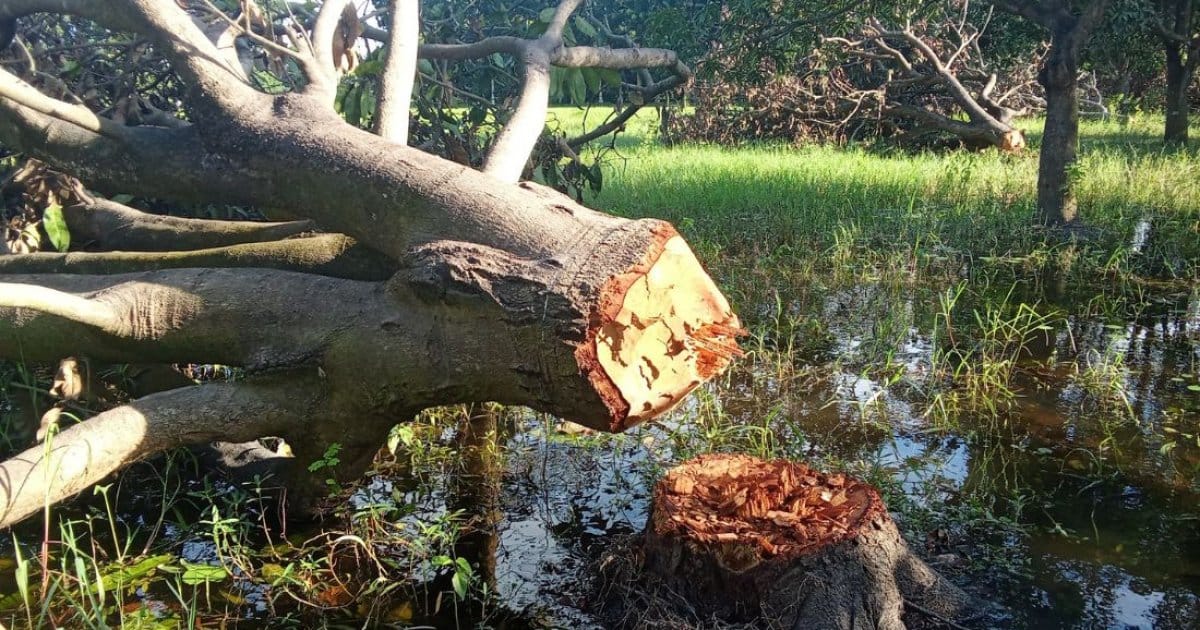In the last five years, Rajshahi city has lost 26% of its green trees, a decline that experts believe could trigger natural disasters in the coming years.
Additionally, the city’s water bodies have decreased by 3%. These findings come from a recent joint study on greenery and waterlogging conducted by researchers from Rajshahi University and Ohio State University in the United States.
The study revealed that between 1990 and 2023, the average winter temperature in Rajshahi increased by 2.66℃, with some areas recording rises of over 4℃. The trend of warming is attributed to the loss of green spaces and water bodies.
Currently, 2,631 trees are being cut down across three ongoing development projects in Rajshahi. Among these, the Rajshahi Medical University’s permanent campus construction involves the largest number of trees being felled.
Trees are also being removed for a Rajshahi Wasa (Water Supply and Sewerage Authority) project and within the Rajshahi Circuit House compound. Environmental activists, however, have long protested against these actions.
According to project officials, 1,853 trees of varying sizes will be cut down to build the permanent campus of Rajshahi Medical University.
The Surface Water Treatment Plant project of Rajshahi Wasa involves cutting 726 trees along one side of a 30-kilometer stretch of road.
For the expansion of the Circuit House, 52 trees have been marked for removal, though felling has not yet begun.
Officials claim that cutting trees is necessary for development, arguing that progress is impossible otherwise.
Environmentalists counter that these projects are stripping away the city’s green cover in the name of development, warning that in the coming years, Rajshahi will face extreme weather conditions, with summer temperatures rising above normal.
The same joint study by Rajshahi University and Ohio State University confirmed that the city’s green areas have declined by 26% over the past five years, while water coverage has dropped by 3%.
Tree cutting is ongoing under the Wasa Surface Water Treatment Plant project. Trees along the Rajshahi-Chapainawabganj highway are being removed for a 30-kilometer pipeline stretching from Rajshahi city through Paba and Godagari upazilas.
As part of the Tk4,062-crore project to bring water from the Padma River to the city, at least 112 trees under the Roads and Highways Department have already been cut, while another 306 have been put up for auction.
Officials said around 308 trees under the Forest Department will also be removed. In the Andharkotha area of Paba upazila, rows of mahogany, koroi, akashmoni, and other tree species have already been felled.
Mir Mukut Md Abu Sayeed, executive arboriculturist of the Roads and Highways Department in Rajshahi, said that since Wasa did not allocate any budget for land acquisition, the project was placed on Roads and Highways land, making tree cutting unavoidable.
“When Wasa planned the project, no funds were kept for acquiring land. They designed it keeping our land in mind, which is why roadside trees have to be removed for the pipeline,” he said.
Attempts to contact Wasa’s Chief Engineer, Parvez Mamud, for comment were unsuccessful.
Meanwhile, the Public Works Department has decided to cut 52 trees inside the Rajshahi Circuit House compound to construct a six-story building, a four-story barrack, and a kitchen block.
The trees were auctioned for Tk1.53 lakh, but as of last Saturday, felling had not started. Environmental activists have met with divisional officials, urging them to reconsider the decision.
The largest tree felling plan is in Silinda Mouza of Rajshahi city, where the Rajshahi Medical University is building a permanent campus on 205 acres at a cost of Tk2,257 crore.
The university authorities recently invited bids to cut 1,853 trees, including about 1,000 mango and 689 mahogany trees.
The decision came amid an ongoing investigation into allegations that more than 1,000 trees were illegally felled and removed earlier this year without a tender.
Rajshahi Medical University Vice-Chancellor Professor Mohammad Zawadul Haque said that the tree removal is being done in consultation with stakeholders. “Around 49% of the campus area will remain green. For every tree cut, we will plant multiple new trees,” he said.
Environmental activist Shahidul Islam stated that Rajshahi has now become a city of extreme weather.
“The number of trees is declining rapidly. To stop further tree cutting, we will submit a memorandum to the Divisional Commissioner on Sunday. We have also decided to move to the High Court,” he said.
Nazmul Hossain Raju, member secretary of the Rajshahi Environment Movement Unity Council, warned: “If the authorities do not stop indiscriminate cutting of old trees in the name of development, we will launch a movement.”



